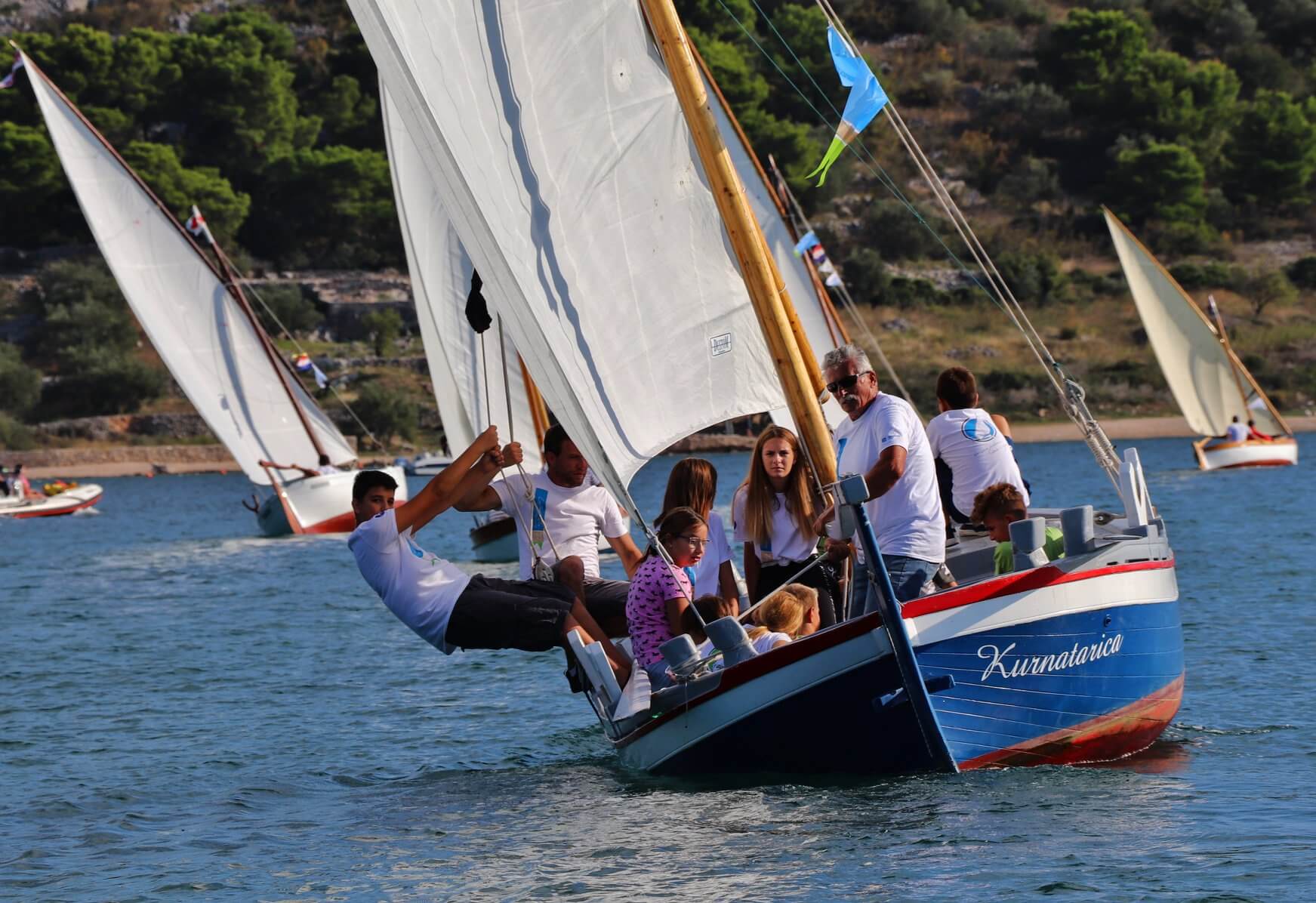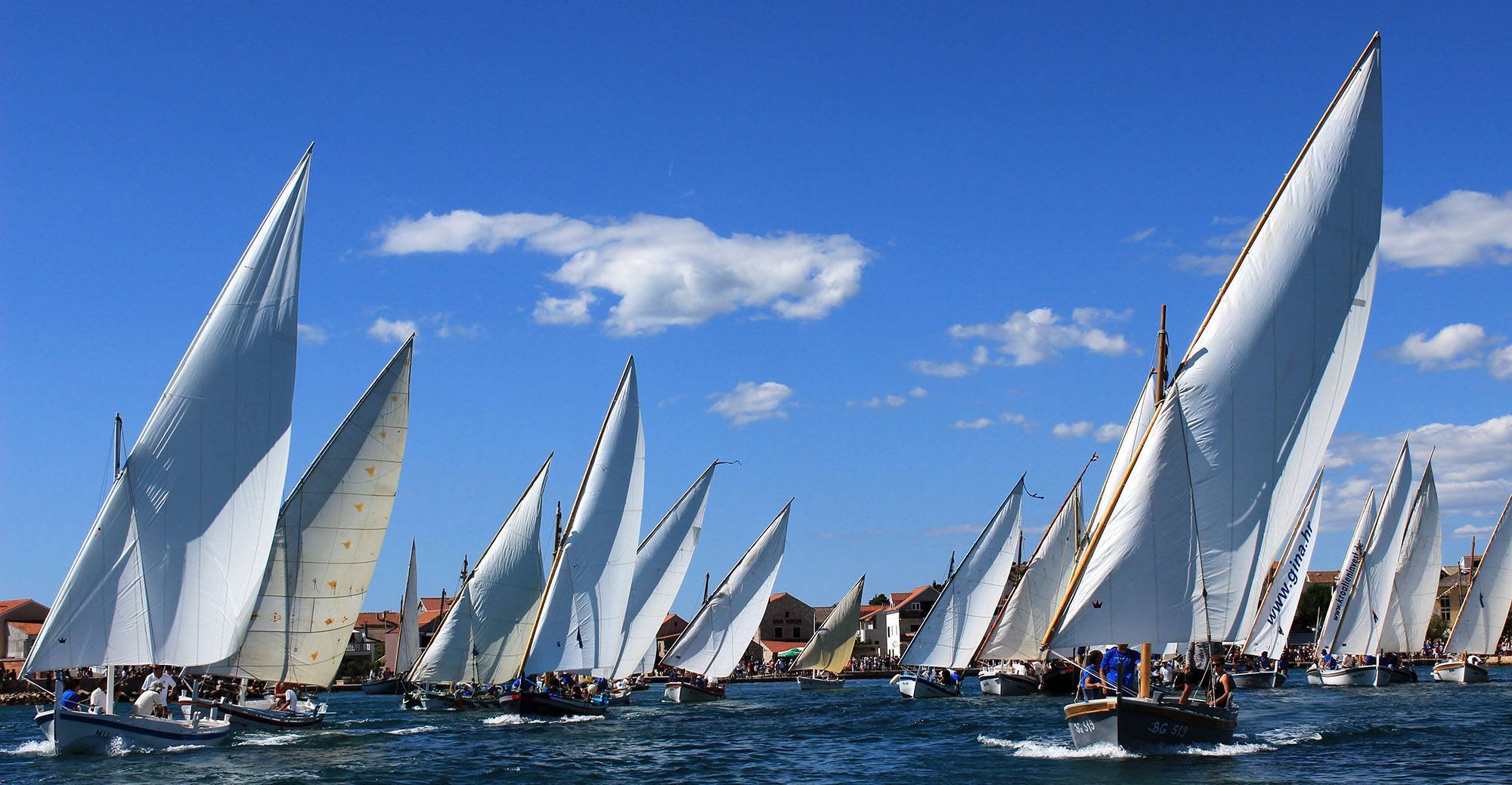Croatian Gajeta Photo Becomes Official European Union Postcard
October 28, 2021 – A Falkuša gajeta from Komiža on Vis island and a Betina gajeta from Murter are shown in a competition-winning Croatian photograph which will now become an official European Union postcard
If you're reading this, chances are you already know Croatia is very often 'postcard-pretty.' Well, it seems you're not the only one to think so.
One Croatian photographer's work has won over judges in a competition to find an official European Union postcard. The photograph (main picture), taken by Hina journalist Andrina Luić shows two sailing boats – a Falkuša gajeta and a Betina gajeta. Both are traditional wooden ships commonly seen in Croatian waters. In the background, the Betina gajeta is instantly recognizable as Croatian because its sail carries a red and white checkerboard pattern.
European Union postcard competition
 © Dani u Vali
© Dani u Vali
The 'Greetings from the Islands' photo competition was published in September by the European Commission's Clean Energy for EU Islands Secretariat (here). Andrina, who is from Lukoran on Ugljan island, took her winning photo two years ago in Stari Grad on the island of Hvar. The sailboats were snapped during the festival of ships, sea and sailors 'Days in Vala' (here). The event is organized by Cronaves of Split, of which Andrina is a member. They are a society with an aim to promote Croatian maritime heritage.
Andrina's photograph will now help promote Croatian maritime heritage all across the continent. Thousands will see the traditional wooden ships and their sails when the image is made into an official European Union postcard. The picture triumphed above other island photo entries from Italy, Spain, Germany, Portugal and elsewhere in Croatia. The evaluation criteria were originality, creativity, overall artistic impression and composition, and visual appeal. Each competitor was only allowed to enter one photo into the competition. It would seem that Andrina - who has been taking photographs for many years - made exactly the right choice.
Falkuša gajeta from Komiža on Vis island and Betina gajeta from island Murter
 Traditional gajeta ships from Betina in a regatta around island Murter © Neven Jović
Traditional gajeta ships from Betina in a regatta around island Murter © Neven Jović
A Falkuša gajeta is a thinner and faster version of the Murter-style gajeta. Falkuša boats have been used for fishing in the area of islands Vis and Korčula since at least the 16th century. They were adapted to the needs of fishermen from Komiža on Vis island, who would regularly travel far out into the open sea - as far west as the Palagruža archipelago - to chase their catch.
The template of these boat designs was taken to Betina on Murter island by Korčula shipbuilder Paško Filippi in the first half of the 18th century. There he founded a shipyard and began building his boats, adapting them to the slightly different climate and the very different needs of the locals.
The people of Murter and its surroundings needed a boat as much for transportation of goods as they did for fishing. Therefore, the Betina gajeta was made stronger, wider, bigger and more load-bearing, with a deck at the bow and stern. They were commonly used to transport goods between Murter and estates on the Kornati islands.
You can today visit an award-winning museum (here) dedicated to the history of this wooden boat building in Betina, island Murter. Or, if you can't make it there any time soon, you can now make do with one of Andrina's postcards until you can.
Betina Museum of Wooden Shipbuilding Wins Europa Nostra Award
As Morski writes on the 30th of October, 2019, the popular and fascinating Betina Museum of Wooden Shipbuilding received the prestigious Europa Nostra European Heritage Award in the Education, Learning and Awareness category at last night's Grande Soirée du Patrimoine Européen ceremony at the Théâtre du Châtelet in the French capital of Paris.
The director of the Betina Museum of Wooden Shipbuilding, Kate Šikić Čubrić, accepted the award on behalf of this unique museum which pays hommage to the village on the island of Murter that is unfortunately one of few remaining centres of small wooden shipbuilding on the whole of the Croatian Adriatic in the modern day.
The ceremony which was held in the glamorous French capital city is considered to be the most festive part of the European Cultural Heritage Summit program, which has been taking place in Paris this year from October the 27th to the 30th.
The whole event took place under the auspices of the French President Emmanuel Macron, and Croatia certainly shone brightly once again.
Watch the video which was uploaded by Europa Nostra's YouTube channel back in May this year which details more information on this award:
Make sure to follow our dedicated lifestyle page for much more.
Betina Museum of Wooden Shipbuilding Wins European Heritage Award!
The European Commission and Europa Nostra, the leading European heritage organization, announced this year's winners of the European Heritage Award/Europa Nostra Awards, the most prestigious European awards in this area, funded by the Creative Europe program, reports HRTurizam on May 21, 2019.
An independent jury of heritage experts from across Europe examined a total of 149 applications filed by organizations and individuals from 34 European countries and selected the winners. Amongst this year's winners in the Education, Training and Awareness-raising category, is the outstanding Betina Museum of Wooden Shipbuilding.
The museum keeps its knowledge of traditional wooden shipbuilding, which is an indispensable part of the Croatian maritime heritage and thus an important part of European maritime cultural heritage.
Among some of the dedicated individuals and positive initiatives of European heritage awarded in 2019 are: the conservation of the Chapel of the Holy Shroud in Turin, a unique place of religious heritage destroyed in the 1997 fire which is now reopened to the public; the development of a digital archive of Roma, an internationally accessible space that makes Roma culture and history visible, and responds to the usual stereotypes and stories of the unexplored history that the Roma have told themselves; the commitment of one of the oldest non-governmental organizations in Europe that has been committed to heritage protection in Norway for more than 175 years; and a training program for displaced heritage experts from Syria, run by the German Institute in Istanbul, which serves as a powerful example for the countries of Europe, but also wider. You can find the full list here.
Thee Betina Museum of Wooden Shipbuilding is located in a protected cultural and historical building in Betina in the very center of town, in a building which has its own cultural, historical, and architectural importance. Betina is a small town of typical Dalmatian architecture, with around 800 inhabitants, mainly engaged in tourism, agriculture, fisheries, trades, and crafts.
“The town of Betina, on the island of Murter, is one of the few places along the Dalmatian Coast where the art of wooden shipbuilding has survived. It is known for its Gajeta, a sleek boat equipped with a lateen sail that has an important role in the daily life of the local community in Betina. In 2011, fearing the disappearance of a practice that has been so central in the culture of Betina for the past 300 years, the local community took action and formed the Betina Gajeta 1740 association. The association’s endeavors resulted in the foundation of the Betina Museum for Wooden Shipbuilding in 2015, an institution dedicated to the maritime heritage of the region. The Municipality of Tisno, the Ministry of Tourism, the Ministry of Regional Development and the Ministry of Culture have each provided financial support to the Museum,” writes Europa Nostra in their description about the award winner.
The highlight of Betina shipbuilders can be summarized with the Gajeta, a wooden ship of 5 to 8 meters long and 2 to 2.6 meters wide, with a sail as the main propulsion. The craftsmanship of this wooden boat was recognized by the Ministry of Culture of the Republic of Croatia and incorporated into the Register of Cultural Property of the Republic of Croatia as an intangible cultural heritage.
"The museum collection is a witness of the community’s generosity and passion for this topic. Many of the collected pieces have been donated and many of the Museum’s texts and video material feature locals who gladly shared their stories and experience. The Betina Museum is, however, much more than a displayed collection. The museum staff organizes and participates in folklore demonstrations, sailing and rowing regattas, workshops, lectures, and many other cultural events to keep the shipbuilding tradition alive," Europa Nostra continued on their website.
“The project reinforces the central notion of the sea as a vital component of European heritage and reinforces community links with it. It also highlights the centrality of all aspects of maritime culture in daily life in the region,” the Europa Nostra jury stated.
“The project also has a strong entrepreneurial element that realizes the economic potential of local inherited shipbuilding traditions, in response to unsustainable global trends in ship construction,” the jury concluded.
Bravo to the Betina Museum of Wooden Shipbuilding on this incredible honor!
To read more about lifestyle in Croatia, follow TCN’s dedicated page.
Best European Museum of the Year, in Croatia: Betina Museum of Wooden Shipbuilding!
May 14, 2018 - Splendid news from Murter island: the Museum of Wooden Shipbuilding in Betina town now has a major award to boast!
Exhibition of the Week: Discovering Folk Costumes of Šibenik Archipelago
Our cultural highlight of the week takes us to Šibenik
Maestri of Murter: Betina Museum of Wooden Shipbuilding
We live on an island. We could say the ship came first, the islanders second. One had to build the ship in order to arrive at the island and become an islander. A fascinating insight into the shipbuilding tradition on Murter island in the Betina museum


